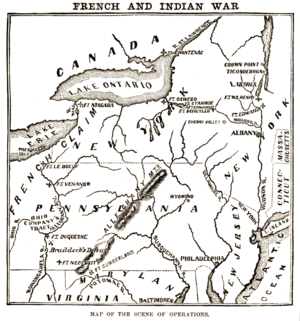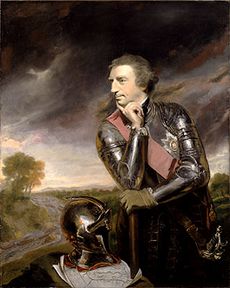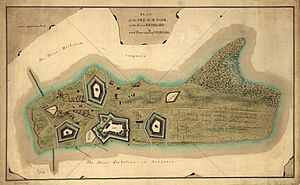Battle of Ticonderoga (1759) facts for kids
Quick facts for kids Battle of Ticonderoga |
|||||||
|---|---|---|---|---|---|---|---|
| Part of the French and Indian War | |||||||
 Map showing the overlapping French and British claims in New York and Pennsylvania |
|||||||
|
|||||||
| Belligerents | |||||||
| Commanders and leaders | |||||||
| François-Charles de Bourlamaque | Jeffery Amherst Richard Montgomery |
||||||
| Strength | |||||||
| 400 regulars and provincial troops | 11,376 regulars and provincial troops | ||||||
| Casualties and losses | |||||||
| 40 captured | 5 killed 31 wounded |
||||||
The Battle of Ticonderoga in 1759 was a small but important fight. It happened at Fort Carillon, which was later called Fort Ticonderoga. This battle took place on July 26 and 27, 1759, during the French and Indian War. A large British army, over 11,000 soldiers, led by General Jeffery Amherst, brought their cannons to a high spot above the fort. Inside the fort, only 400 French soldiers, led by General François-Charles de Bourlamaque, were ready to defend it.
Instead of fighting, General de Bourlamaque followed orders from General Louis-Joseph de Montcalm and the governor of New France, the Marquis de Vaudreuil. He pulled his soldiers out of the fort. They tried to blow up the fort as they left. The fort's powder magazine (where gunpowder was stored) was destroyed. However, the fort's walls were not badly damaged.
The British then took over the fort. They started calling it Fort Ticonderoga. They also began to improve the area and build boats for fighting on Lake Champlain. The French plan stopped Amherst's army from joining James Wolfe at the Battle of the Plains of Abraham. But it also meant 3,000 French soldiers were busy elsewhere. They could not help defend Quebec. The British saw the capture of Fort Ticonderoga as a big win. A year before, a large British army had failed to capture it. This victory helped make 1759 a "Miracle Year" for the British.
Contents
Why was the Battle of Ticonderoga fought?
The French and Indian War began in 1754. It was fought over land in what is now western Pennsylvania and northern New York. After some losses in 1756 and 1757, the British started winning in 1758. They captured Louisbourg and Fort Frontenac. The French had only one big win in 1758. A smaller French force defeated a large British army at the Battle of Carillon.
During the winter, French commanders moved most of their soldiers from Fort Carillon. They sent them to defend Quebec City, Montreal, and other French forts. These forts were located on the Great Lakes and the Saint Lawrence River.
What was the importance of Fort Carillon?
Fort Carillon was located near the southern end of Lake Champlain. This spot was very important. It controlled a key portage trail between Lake Champlain and Lake George. This trail was the main travel route between the Hudson River valley and the Saint Lawrence River. When the war started, this area was the frontier (border) between British province of New York and French Canada.
The British had stopped French advances further south in 1755 at the Battle of Lake George. However, the fort was built in a tricky spot. To build on solid rock, the French placed it far from the lake. But it was still below nearby hilltops, which was a disadvantage.
How did the British plan their attack?
For the 1759 war plan, William Pitt, a British leader, gave orders. He told General Jeffery Amherst to lead an army into Canada. Amherst had won at Louisbourg. His plan was to sail north on Lake Champlain. Another British force, led by James Wolfe, would attack Quebec City.
Governors of the Thirteen Colonies were told to gather 20,000 local soldiers (militia). About 8,000 militia men were sent to Albany. These men came from colonies as far south as Pennsylvania and New Jersey. New York sent 3,000 men, and New Jersey sent 1,000. Massachusetts gathered 6,500 men. About 3,500 went to Albany, and the rest went to help Wolfe at Quebec. Other men came from New England and Pennsylvania.

When Amherst learned that the Iroquois League would help the British, he sent a group to capture Fort Niagara. He sent 2,000 militia and 3,000 regular soldiers west from Albany. These troops were led by General John Prideaux. Amherst led the rest of the militia, mainly from Massachusetts, New Jersey, and Connecticut, north to Fort Edward. There, they joined 6,000 regular soldiers. This group included Royal Highlanders, other regiments, Royal Artillery, Rogers' Rangers, and light infantry.
What was the French strategy?
In 1759, French war planners focused most of their resources on the war in Europe. In February, France's war minister told General Louis-Joseph de Montcalm that Canada would not get much help from France. This was because the English navy controlled the Atlantic Ocean. Sending a large army across was too risky. The minister told Montcalm how important it was to keep some land in North America. Otherwise, it would be almost impossible to get it back. Montcalm replied, "Canada will fall unless we have unexpected luck." He noted that the English had 60,000 men, while the French had only 11,000.
Your task is not to beat the enemy but to avoid being beaten.
June 4, 1759
Montcalm decided to use his soldiers to defend the main parts of Canada. These included Montreal, Quebec City, and the Saint Lawrence River Valley. He placed 3,000 soldiers under General François-Charles de Bourlamaque. These troops were to defend the area south of Montreal. About 2,300 of them were sent to Fort Carillon. Montcalm knew this force was too small to hold Carillon against a strong attack. He had learned this from his own experience the year before.
Montcalm and Governor Vaudreuil gave orders to de Bourlamaque. He was to hold Carillon for as long as possible. Then, he was to destroy it and nearby Fort St. Frédéric. After that, he was to retreat toward Montreal.
British advance and French retreat
General Amherst was ordered to move his army by May 7. However, his army of 11,000 soldiers did not leave Lake George until July 21. There were a few reasons for this delay. One reason was that Prideaux's expedition to Forts Oswego and Niagara also left from Albany. Another reason was the slow arrival of the local militia.
When his troops landed and moved towards the fort, Amherst was happy. He learned that the French had left their outer defenses. He still moved carefully. On July 22, he took over the old French lines from the 1758 battle. He heard reports that the French were loading their boats at the fort. His first plan was to go around the fort. This would cut off the road to Fort St. Frédéric and stop the French from escaping. Since there was no French resistance outside the fort, he decided to focus on the fort itself.
For the next three days, the British dug trenches and started building siege lines. These lines would bring them closer to the fort. This work was hard because there was not much soft ground to dig near the fort. They needed sandbags to protect their siege works. During this time, the French cannons fired heavily at the British. On July 25, some of Rogers' Rangers launched boats onto the lake. They cut a log boom that the French had placed to stop ships. By July 26, the British had moved their cannons to within 600 feet (180 meters) of the fort's walls.
Bourlamaque had already left with all but 400 of his men. He went to Fort St. Frédéric as soon as he knew the British were coming. The cannon fire from this small French force killed five British soldiers and wounded 31 others. Captain Louis-Philippe Le Dossu d'Hébécourt was in charge of the fort. On the evening of July 26, he decided it was time to leave. His men pointed the fort's guns at its own walls. They also set up mines and a powder trail to the large powder magazine. Then they lit the fuse and left the fort, leaving the French flag flying.
French soldiers who deserted told the British what was happening. General Amherst offered 100 guineas (a type of money) to anyone who would go into the fort and put out the fuse. But no one was brave enough to do it. The entire fort exploded late that evening with a huge noise. The powder magazine was destroyed, and some wooden buildings caught fire. But the fort's walls were not badly damaged. After the explosion, some British light infantry rushed into the fort. They managed to get the French flag. Fires in the fort continued to burn for two days.
What happened after the battle?
The British began to occupy the fort the next day. Because the French left so quickly, one of their scouting parties returned to the fort. They thought it was still in French hands. Forty of these men were taken prisoner.
The retreating French destroyed Fort St. Frédéric on July 31. This cleared the way for the British to start operations on Lake Champlain. The French had a small armed fleet on the lake. This fleet needed to be defeated first. The time it took to capture and repair the two forts, plus building ships for Lake Champlain, delayed Amherst's forces even more. This stopped him from joining General Wolfe at the siege of Quebec. Amherst worried that Bourlamaque's retreat might be a trap. So, he spent August and September building a small navy. He also built Fort Crown Point (a new fort near the ruins of Fort St. Frédéric). He also oversaw the building of supply roads from New England.

On October 11, Amherst's army began to sail and row north on Lake Champlain. They planned to attack Bourlamaque's position at the Île-aux-Noix in the Richelieu River. Over the next two days, one of the French ships was captured. The French then abandoned and burned their other ships. This was to stop the British from capturing them. On October 18, Amherst heard that Quebec had fallen. Winter was coming, and parts of the lake were starting to freeze. Also, the militia's time of service was ending on November 1. So, Amherst called off his attack. He sent his militia home and moved his army to winter camps.
The British finally took control of Canada when Montreal surrendered in 1760. Fort Carillon was always called Ticonderoga by the British. They held it until the end of the French and Indian War. After that war, only small groups of soldiers were stationed there. But in 1775, it was captured by American militia early in the American Revolutionary War.
See also
 In Spanish: Batalla de Ticonderoga para niños
In Spanish: Batalla de Ticonderoga para niños

